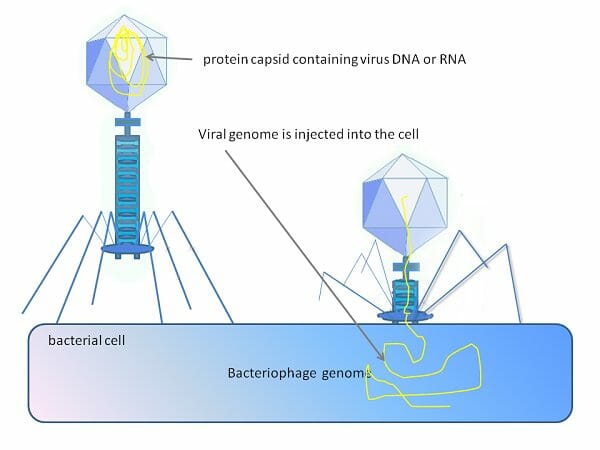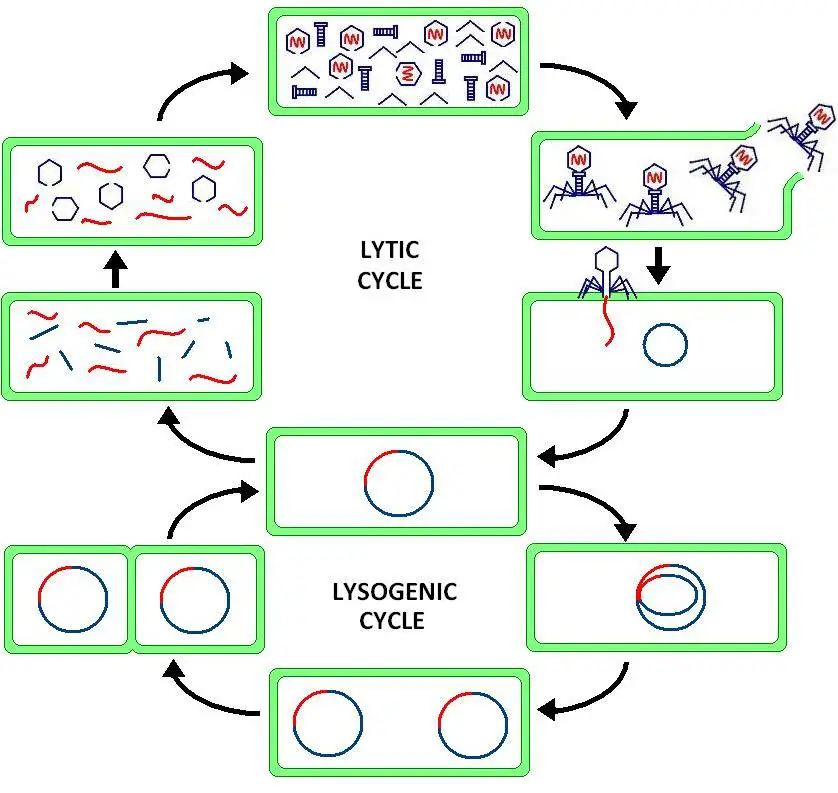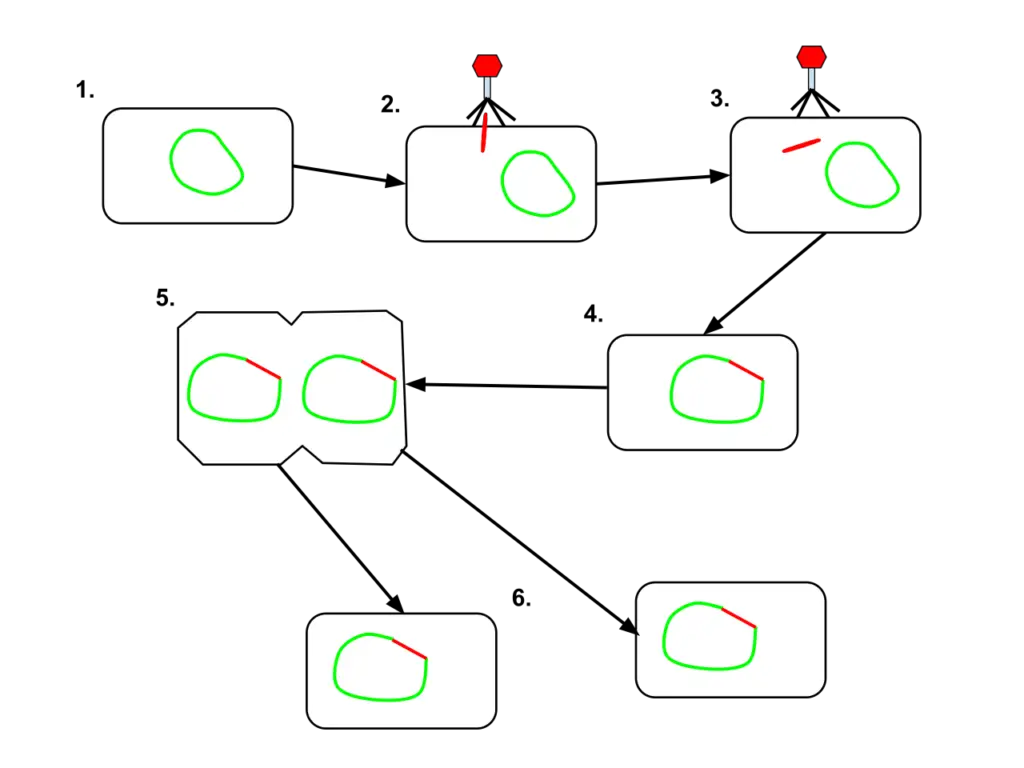Table of Contents
What is Lysogenic Cycle?
- The lysogenic cycle, a fundamental process in virology, represents one of the two primary mechanisms by which viruses propagate and maintain their genetic material within host organisms. This cycle stands in contrast to the lytic cycle, which leads to the immediate production of viral progeny and subsequent lysis of the host cell.
- In the lysogenic cycle, a virus introduces its nucleic acid into the host cell, where it integrates into the host’s genome or forms a stable circular replicon within the bacterial cytoplasm. This integrated viral DNA, termed a prophage, remains dormant within the host, allowing the host cell to continue its normal life processes and replicate.
- As the bacterium divides, the prophage is transmitted to the progeny, ensuring the persistence of the viral genetic material across generations. This state of dormancy can be disrupted by specific external stimuli, such as ultraviolet radiation or certain chemicals, prompting the prophage to initiate the lytic cycle.
- During this transition, the viral DNA becomes active, leading to the synthesis of new viral particles, which eventually results in the lysis of the host cell and release of the viral progeny.
- A distinguishing feature of the lysogenic cycle is its non-destructive nature, at least initially. The viral DNA coexists harmoniously with the host’s genetic material, without causing immediate harm.
- This is in stark contrast to the lytic cycle, where rapid viral replication culminates in the destruction of the host cell.
- Notably, while the lysogenic cycle is predominantly observed in prokaryotic organisms, instances of lysogeny in eukaryotes have been documented, though the exact mechanisms remain to be elucidated.
- Viruses that exclusively undergo the lytic cycle are termed virulent phages. In contrast, those capable of both lysogenic and lytic replication are referred to as temperate phages. The decision between these two cycles is influenced by various environmental and cellular factors.
- In summary, the lysogenic cycle offers viruses a strategic advantage, allowing them to persist within host populations over extended periods without causing immediate damage. This stealth mode of replication ensures the long-term survival of the virus, while also retaining the potential to switch to the more aggressive lytic mode when conditions are favorable.
Definition of Lysogenic Cycle
The lysogenic cycle is a viral replication process in which a virus integrates its genetic material into the host cell’s genome, allowing it to remain dormant and propagate without immediately destroying the host. This dormant viral DNA, known as a prophage, can later be activated to initiate the lytic cycle, leading to active viral replication and host cell lysis.

Bacteriophage
- Bacteriophages, commonly referred to as phages, are specialized viruses that exclusively target and replicate within bacterial cells. The term “bacteriophage” is derived from the words “bacteria” and “phagein,” meaning to consume, a nomenclature credited to Félix d’Hérelle. The discovery of bacteriophages is attributed to both Frederick W. Twort in the United Kingdom and d’Hérelle in France, who independently identified these entities.
- Bacteriophages are ubiquitously present in various environments across the globe, making them one of the most abundant biological entities. Their prevalence is especially notable in aquatic ecosystems, and they significantly contribute to the terrestrial biomass, second only to prokaryotes. Beyond bacteria, certain phages also have the capability to infect members of the archaeal domain.
- Structurally, bacteriophages exhibit a degree of diversity based on the specific bacterial species they target. However, a universal feature among all phages is the presence of a nucleic acid genome, which can be either DNA or RNA, encapsulated within a protein coat known as a capsid.
- The dimensions of phages can range from 24 to 200 nm, and their morphological forms include those with a tetrahedral head and tail, those with just a tetrahedral head, and threadlike structures. The specificity of bacteriophages is remarkable, often limited to a particular bacterial species or even specific strains within that species.
- The life cycle of a bacteriophage typically begins with its attachment to a susceptible bacterial cell, followed by the injection of its genetic material. Once inside, the phage can harness the host’s cellular machinery to replicate and produce progeny. This interaction can either be detrimental to the host bacterium or result in a harmonious coexistence.
- Recent scientific endeavors have highlighted the potential applications of bacteriophages in various fields. One of the most promising areas is their use as an alternative or adjunct to antibiotics, capitalizing on their innate ability to infect and potentially eliminate pathogenic bacteria. This approach is particularly appealing given the rising concerns of antibiotic resistance.
- In taxonomic terms, bacteriophages are categorized into distinct families based on their morphological attributes and genetic constitution. Some of the well-researched phage families encompass Inoviridae, Tectiviridae, Microviridae, and Rudiviridae.
- In summation, bacteriophages represent a fascinating group of viruses with a rich history, intricate biology, and promising applications in the realm of biomedicine and biotechnology.

Lysogenic Cycle Steps
The lysogenic cycle is a sophisticated mechanism employed by viruses, particularly bacteriophages, to propagate their genetic material within bacterial hosts. This cycle is characterized by a series of methodical steps, ensuring the virus’s survival and potential for future proliferation. Herein, we delineate the steps involved in the lysogenic cycle:

- Step 1: Viral Attachment and DNA Injection: A bacteriophage recognizes and binds to a specific receptor on a bacterial cell’s surface. Following this attachment, the bacteriophage introduces its genetic material into the bacterial cytoplasm, the fluidic compartment enclosed by the cell membrane.
- Step 2: Integration of Viral DNA: Once inside the bacterial cell, the viral DNA is processed by bacterial replication machinery. This machinery, which typically functions to replicate the bacterial genome, now serves to replicate the viral DNA.
- Step 3: Maintenance in Lysogenic State: In this phase, the viral DNA remains predominantly dormant, coexisting with the bacterial genome. This state allows the viral DNA to be replicated concomitantly with the bacterial DNA during the bacterial cell’s normal replication processes. As a result, the viral genetic material is propagated without causing immediate harm to the host.
- Step 4: Induction to Lytic Cycle: Under certain conditions, the dormant viral DNA can be activated, marking a transition from the lysogenic to the lytic cycle. In this phase, the bacterial machinery is co-opted to produce a significant quantity of viral DNA and the associated protein capsids.
- Step 5: Assembly and Release: The newly synthesized viral DNA is packaged into the protein capsids, forming mature virions. These virions are subsequently released into the surrounding environment, often following the lysis of the bacterial host. These released virions are primed to infect new bacterial cells, potentially reinitiating the lysogenic cycle or proceeding directly to the lytic cycle, especially if the prospective host is in a compromised state.
In essence, the lysogenic cycle offers a strategic avenue for viruses to ensure their persistence within host populations, while also retaining the capability to shift to a more aggressive replication mode when conditions are conducive.
Importance of Lysogenic Cycle
The lysogenic cycle is a pivotal process in the life cycle of many viruses, particularly bacteriophages, and plays a significant role in the interactions between viruses and their host organisms. The importance of the lysogenic cycle can be understood from various biological, ecological, and evolutionary perspectives:
- Persistence and Survival: The lysogenic cycle allows viruses to persist within host populations without causing immediate harm. By integrating their genetic material into the host genome and remaining dormant, viruses can ensure their survival during unfavorable conditions or when the host population density is low.
- Genetic Exchange and Horizontal Gene Transfer: The integration of viral DNA into the host genome can lead to the transfer of genetic material between different bacterial strains or species. This process, known as horizontal gene transfer, can introduce new genetic traits to bacterial populations, potentially conferring advantages such as antibiotic resistance.
- Regulation of Host Population: The ability of a prophage (dormant viral DNA) to switch from the lysogenic to the lytic cycle can serve as a regulatory mechanism for host population density. When the host population becomes dense, some prophages may be induced to enter the lytic cycle, leading to lysis of host cells and a subsequent reduction in population.
- Protection Against Superinfection: Bacteria that harbor prophages often exhibit resistance to superinfection by other viruses. This phenomenon, known as superinfection immunity, provides a competitive advantage to the lysogenized bacteria against other phage infections.
- Contribution to Host Fitness: In some cases, genes carried by the prophage can confer beneficial traits to the host bacterium. For instance, certain toxins produced by pathogenic bacteria are encoded by phage genes. The presence of these genes can enhance the virulence of the bacterium, aiding in its survival and proliferation within host organisms.
- Evolutionary Implications: The lysogenic cycle contributes to the genetic diversity of both viruses and their host organisms. This diversity can drive evolutionary processes, leading to the emergence of new viral strains or bacterial species with novel traits.
- Biotechnological Applications: The principles of the lysogenic cycle have been harnessed in biotechnology. For instance, temperate phages are used in phage typing, a technique to classify bacterial strains. Additionally, the molecular mechanisms underlying the lysogenic cycle have informed various genetic engineering techniques.
In essence, the lysogenic cycle is not merely a passive or dormant phase in the viral life cycle but is a dynamic process with profound implications for microbial ecology, evolution, and the broader biological landscape.
Quiz
What is the primary characteristic of the lysogenic cycle?
a) Immediate destruction of the host cell.
b) Integration of viral DNA into the host genome.
c) Rapid production of viral progeny.
d) Release of virions without host cell lysis.
Which term refers to the dormant viral DNA integrated into the host genome during the lysogenic cycle?
a) Viroid
b) Prophage
c) Retrovirus
d) Capsid
Under which condition might a virus in the lysogenic cycle switch to the lytic cycle?
a) High host population density.
b) Exposure to ultraviolet radiation.
c) Availability of nutrients.
d) Absence of host cells.
Which cycle allows the virus to coexist with the host without causing immediate harm?
a) Lytic cycle
b) Replicative cycle
c) Lysogenic cycle
d) Transformation cycle
What prevents a lysogenized bacterium from being infected by the same type of phage?
a) Cellular immunity
b) Superinfection immunity
c) Antigenic shift
d) Phage resistance
Which entity is responsible for the replication of viral DNA during the lysogenic cycle?
a) Viral enzymes
b) Bacterial ribosomes
c) Bacterial replication machinery
d) Host cell mitochondria
Which type of viruses primarily undergo the lysogenic cycle?
a) Retroviruses
b) Bacteriophages
c) Influenza viruses
d) Rhinoviruses
What is the primary outcome for the host cell at the end of the lysogenic cycle?
a) The host cell lyses immediately.
b) The host cell produces viral proteins.
c) The host cell continues its normal functions.
d) The host cell undergoes apoptosis.
Which factor can trigger the transition from the lysogenic cycle to the lytic cycle?
a) High nutrient availability
b) Absence of other viruses
c) Presence of specific chemicals
d) Low temperature
In the lysogenic cycle, where does the viral DNA primarily reside?
a) Outside the host cell
b) Within the viral capsid
c) Integrated into the host genome
d) In the host cell cytoplasm
FAQ
What is the lysogenic cycle?
The lysogenic cycle is a viral replication process where the virus integrates its genetic material into the host cell’s genome, allowing it to remain dormant and propagate without immediately destroying the host.
How does the lysogenic cycle differ from the lytic cycle?
While the lytic cycle leads to the immediate production of viral progeny and subsequent lysis of the host cell, the lysogenic cycle involves the integration of viral DNA into the host genome, allowing the virus to remain dormant.
What triggers a virus in the lysogenic cycle to enter the lytic cycle?
Various factors, such as exposure to ultraviolet radiation or certain chemicals, can induce the dormant viral DNA to become active and initiate the lytic cycle.
Is the host cell destroyed in the lysogenic cycle?
No, in the lysogenic cycle, the host cell is not immediately destroyed. Instead, the viral DNA remains integrated and dormant within the host genome.
What is a prophage?
A prophage refers to the dormant viral DNA that is integrated into the host bacterium’s genome during the lysogenic cycle.
Can a bacterium with a prophage be infected by other viruses?
Bacteria that harbor prophages often exhibit resistance to superinfection by other viruses of the same type, a phenomenon known as superinfection immunity.
Why is the lysogenic cycle considered a stealth mode of viral replication?
The lysogenic cycle allows viruses to coexist harmoniously with their host, ensuring their survival and propagation without drawing attention or causing immediate harm.
Do all viruses undergo a lysogenic cycle?
No, not all viruses undergo a lysogenic cycle. Some viruses only undergo the lytic cycle, while others, especially bacteriophages, can undergo both lysogenic and lytic cycles.
What role does the lysogenic cycle play in bacterial evolution?
The integration of viral DNA into the bacterial genome can lead to horizontal gene transfer, introducing new genetic traits to bacterial populations. This can drive evolutionary processes and lead to the emergence of bacterial strains with novel characteristics.
Are there any medical or biotechnological applications related to the lysogenic cycle?
Yes, understanding the lysogenic cycle has implications in developing phage therapies, where bacteriophages are used to target and kill pathogenic bacteria, offering a potential alternative to traditional antibiotics.
References
- https://biologydictionary.net/lysogenic-cycle/
- https://www.geeksforgeeks.org/lysogenic-cycle/
- https://www.biologydiscussion.com/viruses/replication-of-virus-lytic-and-lysogenic-cycle/47112
- https://www.newworldencyclopedia.org/entry/Lysogenic_cycle
- https://www.archaealviruses.org/terms/lysogenic_cycle.html
- https://thebiotechnotes.com/2019/05/04/bacteriophage-reproduction-lysogenic-cycle/
- https://www.jove.com/science-education/10824/prophage-and-lysogenic-cycle-of-bacteriophages
- https://www.biologyonline.com/dictionary/lysogenic-cycle
